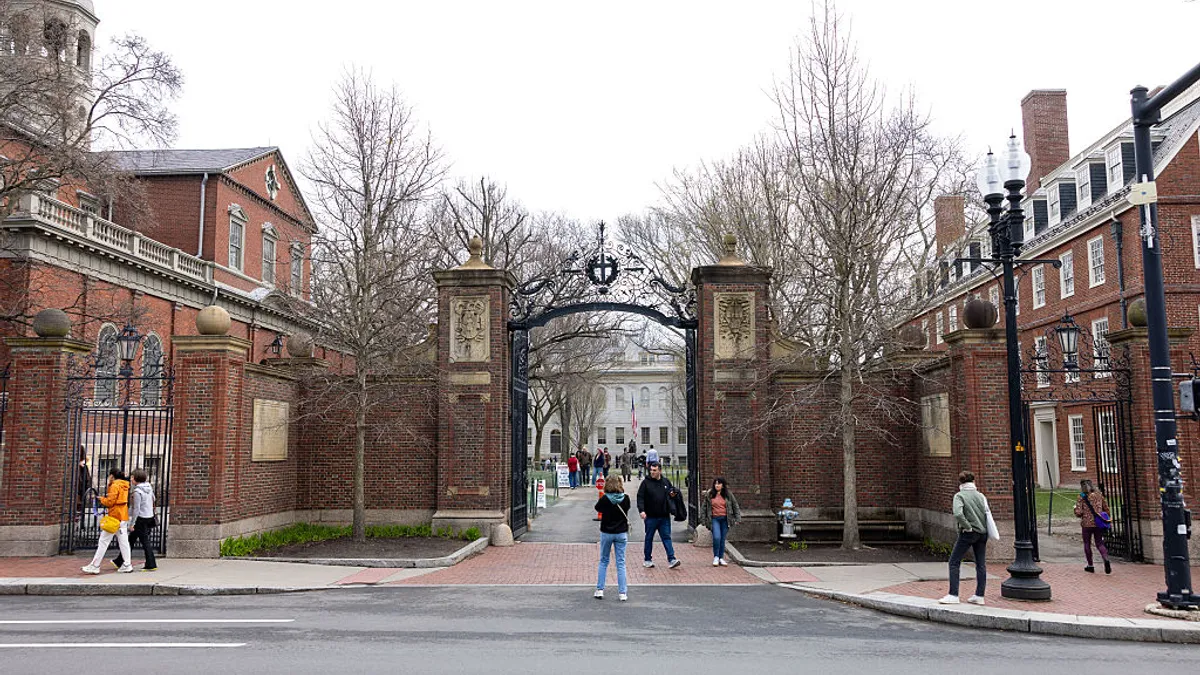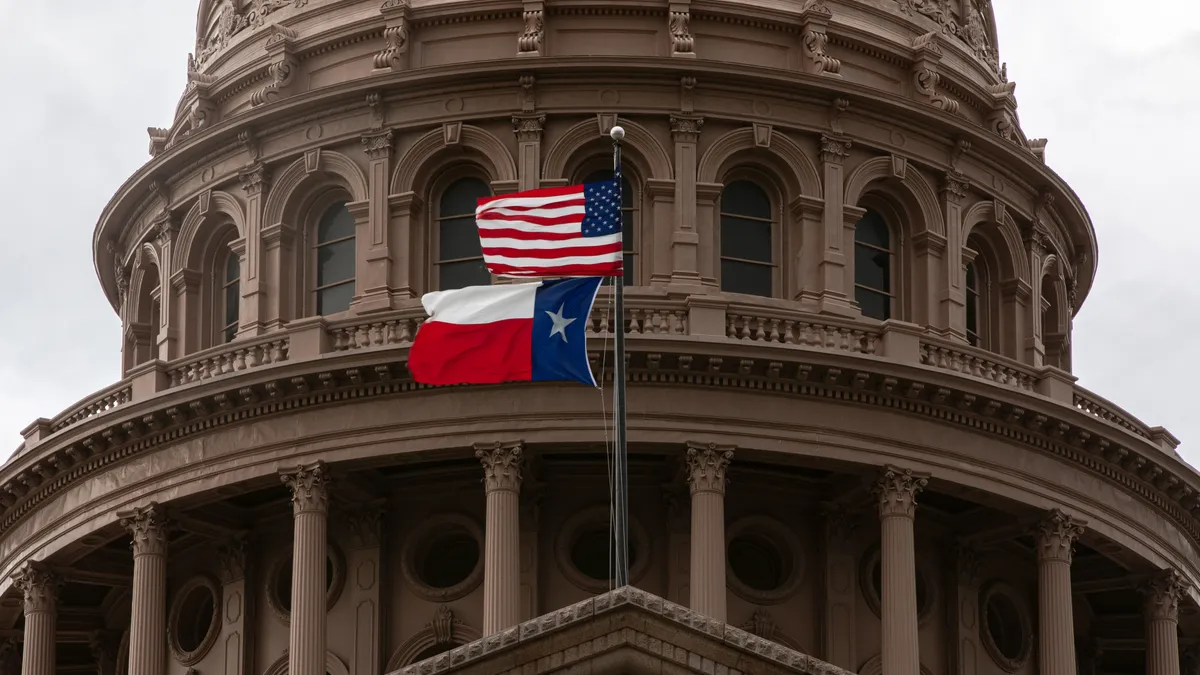The University of Utah wanted to raise graduation rates but was coming up short. The usual tactics — such as better analytics and academic advising — weren't cutting it.
That's because the problem wasn't students' academic abilities. It was money. Talking with students, university officials found many took longer to graduate because they were reluctant to take out loans.
"Instead of continuing through as a full-time student, they in their last year or two will start and stop and reduce credit hours and go work two jobs or even stop out completely" to go earn money to fund the rest of their education, said Courtney McBeth, project director and special assistant to the president at the U of Utah.
In search of a financing option that could keep students enrolled full time through graduation, officials landed on the income-share agreement (ISA). The financing tool allows a college to front a portion of students' costs in exchange for a share of their post-graduation income for a set number of years once they reach a predetermined earnings level. That means higher-earning students pay more while lower-earning students pay less, though most contracts cap the repayment amount at around double the amount borrowed.
At the time, Purdue University was one of a few colleges offering ISAs. "We saw what Purdue was doing, and we thought, you know, this could be really interesting," McBeth said.
ISAs are growing in use as a financing source for boot camps and other training programs that don't qualify for federal aid. Traditional colleges are eyeing ISAs, too, with around 30 offering or accepting them. While boot camps tend to use ISAs to fund tuition in full, colleges so far are using them to achieve specific goals, resulting in smaller sums issued to a subset of students.
But with student debt levels climbing and colleges struggling to stem tuition increases, ISAs in traditional higher ed are not without scrutiny. While proponents view them as a lower-risk, interest-free alternative to some kinds of student loans, critics say they amount to debt from students' point of view and don't force colleges to address rising costs.
Those concerns heightened in recent months after the U.S. Department of Education suggested it may pilot an ISA program. That spurred Congressional Democrats to ask for details, fueling more questions about how ISAs work.
Below, we examine some of those questions for colleges considering ISAs.
How are colleges using ISAs?
Colleges tend to use ISAs to address "some strategic goal around access or opportunity," said Tonio DeSorrento, CEO at Vemo Education, which works with institutions to administer ISAs. "That's why you see such a difference in income-share agreements from college to college," he added.
The U of Utah announced its ISA earlier this year in partnership with Vemo and is enrolling the first cohort of students. An ISA, university officials believe, can help its students graduate faster. "We see this as being a very strategic niche tool to solve a problem we have," McBeth said.
Colorado Mountain College provides another example of a specific use for an ISA: aid for undocumented students. It offers up to $3,000 a year to students in the Deferred Action for Childhood Arrivals program and others who have financial need but aren't eligible for federal aid, qualify as in-state students and are authorized to work in the U.S.
Other targets for ISAs include adult learners who have exhausted their Title IV funding, people who have defaulted on student loans and those with prior convictions that could inhibit their access to aid, DeSorrento said. Some ISAs, like Purdue's Back a Boiler program, are only available to students in their sophomore, junior and senior years. In other cases, such as with Clarkson University's Lewis ISA, students must apply for one of 20 slots.
"With our college clients, we are working around federal financial aid because we don't view ISAs as a replacement for federal grants or loans with the Department of Education," DeSorrento said. "Instead, we are looking in the gaps left by that." Vemo also administers ISAs for Clarkson, Colorado Mountain College and Purdue, among others.
How are ISAs different from other college financing options?
In higher ed, ISAs are viewed as a financing tool for students after they exhaust other aid options such as federal loans, scholarships and grants.
In particular, they can replace PLUS or private loans, said Beth Akers, senior fellow at the Manhattan Institute for Policy Research. "Those are really risky financial products for students because they're on the hook to pay them back whether college works out for them or not," she said. An ISA "takes that last little bit of funding and makes it a lot less risky for them."
The ways in which they differ from private student loans, however, are disputed.
The fundamental difference between an ISA and a student loan is the obligation to repay, said Jeremy Mandell, an attorney with law firm Morrison & Foerster. ISAs don't technically have that feature, he and colleagues argued in a recent brief, because the contract sets a minimum income threshold below which a graduate doesn't owe anything. They also don't charge interest.
Watchdog groups, however, say colleges should be wary of common elements of ISA contracts that can make them equivalent to or more stringent than private loans. According to Joanna Darcus, staff attorney at the National Consumer Law Center, these include:
- Arbitration clauses and class action bans.
- Penalty fees for early repayment that can be around two-and-a-half times the original amount borrowed.
- The possibility a borrower will earn just over the income threshold and therefore struggle to make payments.
The opportunity for borrowers to forgo payment when their income is below a certain point is billed as a benefit. But that may be "oversold," she added, as some contracts tack those missed months onto the end; however, a maximum payment period is common.
"Colleges need to be careful in how they market ISAs and how they describe them in comparison with other tools to make higher education affordable," Darcus said.
Purdue's Mary-Claire Cartwright, who manages the university's ISA, told Education Dive in an email that students receive "three separate disclosures" between the time they apply and when the contact is finalized.
"All three disclosures include information that students may end up paying more than the funding amount," said Cartwright, who is also the vice president of information technology for the Purdue Research Foundation, which supports the ISA. Purdue bills its ISA as an alternative to PLUS and private loans.
What can colleges do to ensure students understand those differences?
Transparency is critical, sources in favor and wary of ISAs told Education Dive.
Before students take on an ISA, The U of Utah requires they meet with a financial aid advisor dedicated to the ISA program to understand their aid package.
Purdue has students take a quiz to ensure they understand how the ISA program works and what their obligations will be, Cartwright said, adding that students are "strongly encouraged" to speak with a financial aid officer. A web-based tool lets students compare ISA outcomes across income levels and compare ISAs to other financing options.
Students who participate in an ISA through the San Diego Workforce Partnership (SDWP) to attend select programs with the University of California, San Diego's Extension must take an online course and related quiz, as well as wait 24 hours, before signing the contract, said Andy Hall, chief operating officer at SDWP. The public agency administers the ISA and helps funnel students into the program.
"In our world, you're quickly going to be into the job, and if you don't like [it], it doesn't matter how we financed it," Hall said. "We had to balance this idea of how much do we get them aware of the … course and the professional experience and how much do we educate them on an ISA."
Worst-case scenarios should also be on college officials' minds when setting up an ISA, said Julie Margetta Morgan, a fellow at the Roosevelt Institute, a left-leaning think tank.
Income thresholds can vary by college, with examples observed by Education Dive ranging from $20,000 to $40,000 per year. Observed income-share percentages fall in the 1%-8% range. How much students can receive also varies, with U of Utah offering $3,000 to $10,000, UCSD's with SDWP at $6,500, and Colorado Mountain College at $3,000 max per year. Clarkson offers up to $10,000 a year.
However, observers note some contracts include penalties for students who earn above the income threshold but can't afford their payments.
In DeSorrento's view, ISA programs are poorly designed when participants earn only just over that level. He suggests income-share percentages vary based on expected post-graduation salaries.
Mandell agrees. "If what you're trying to do is create a fair set of terms across different fields of study, then it may be that the terms of the ISA vary by field of study because expected income is going to vary by field of study," he said.
"Colleges need to be careful in how they market ISAs and how they describe them in comparison with other tools to make higher education affordable."

Joanna Darcus
Staff attorney, National Consumer Law Center
That can result in discrimination, however, a concern Congressional Democrats highlighted in a June letter to the Ed Department pressing for details about its plan to test ISAs.
They point out that because ISAs are cast as an alternative to private student loans, they may be targeted disproportionately at black students, who borrow more heavily to finance college.
Another possibility is that ISAs could be offered only to students or for programs likely to have the strongest payoff in the market. "One of the things schools ought to be taking into account is: What kind of academic program are we trying to set up overall, and how does the addition of ISAs affect that?" Margetta Morgan said.
U of Utah offers its ISA for students in 18 majors, from chemical engineering and economics to communications and special education.
"It was important to test this pilot program across our entire campus, but also select majors where we have some good data points and we could build a successful model," McBeth said.
Colleges should also be aware that students are likely layering an ISA atop federal loans.
"That means they'll be making two payments to two different people, neither one of whom is accounting for the other ones' loan balance," said Clare McCann, deputy director for federal higher ed policy at the nonpartisan think tank New America.
Who funds the ISA can also dictate its priorities. U of Utah is starting its ISA with $6 million from a combination of university funds, donations and impact investments from family foundations, McBeth said. SDWP's ISA is solely philanthropy funded, with $3.25 million raised so far.
"Once we prove that with our consumer protections the fund can still be profitable, then we'll go out to investors," Hall said.
What kind of regulatory oversight are ISAs subject to?
Competing opinions on how loans fit into students' financing bundle stem from differing views on how they should be regulated.
Mandell and others see an answer to that uncertainty in state and federal legislation tailored to ISAs, which could regulate maximum payment amounts for students, length of payment terms and tax treatment.
At the federal level, a bill pending in the U.S. House of Representatives aims to carve out ISA-specific regulatory treatment. That includes allowing ISAs to be classified as "qualified education loans," Darcus said, which would mean they couldn't be readily discharged in bankruptcy.
At the state level, Indiana now has a law that would exempt ISAs there, like Purdue's, from compliance with the state's Uniform Consumer Credit Code, which includes key consumer credit protections. Illinois and California are also considering ISA-specific legislation.
Watchdog groups are less certain separate rules are needed, and Darcus and others contend the current consumer protection framework is sufficient. They are concerned ISA advocates want new legislation "that is advantageous for their business model," she said.
Colleges developing ISAs are also aware of the uncertainty. "It is interesting to develop a program and a financial tool where the regulatory and legislative landscape is still evolving," U of Utah's McBeth said.
Purdue worked with legislators who "have written or talked about ISAs over the years" when developing its program, Cartwright said. She added that their guidance "continues to be a strong guide" as the program evolves.
How can you tell if it's working?
U of Utah officials were confident an ISA would work due to a unique feature of their state: The Church of Jesus Christ of Latter-day Saints has strong influence there and teaches its members to avoid excess debt. That idea is infused in the school's culture. "Students are really unwilling to take out debt and want to be able to work their way through school," McBeth said.
The university is running its program as a five-year pilot with 100 to 150 students expected in the first year. The $6 million fund support between 1,000 and 2,000 students total, McBeth said.
Purdue has so far inked 870 student ISA contracts, with around $10 million raised in funding. Officials there look to students' response and their ability to make their payments as a success indicator.
In San Diego, Hall said he will look at graduates' income over the repayment period, the number of completions (they estimate 80% of students will do so) and how many people surpass the $40,000 income threshold right away in order to determine if the ISA is paying off.
Utah's metrics for success include how many students take the ISA, whether it impacts financial aid packaging and if it correlates with more students registering full time and graduating, she said.
"For us, it's all about this last year or two and how can we help more students graduate in a more timely manner," McBeth said.
Correction: This article has been updated the clarify that Indiana's new law impacts the Uniform Consumer Credit Code.






















